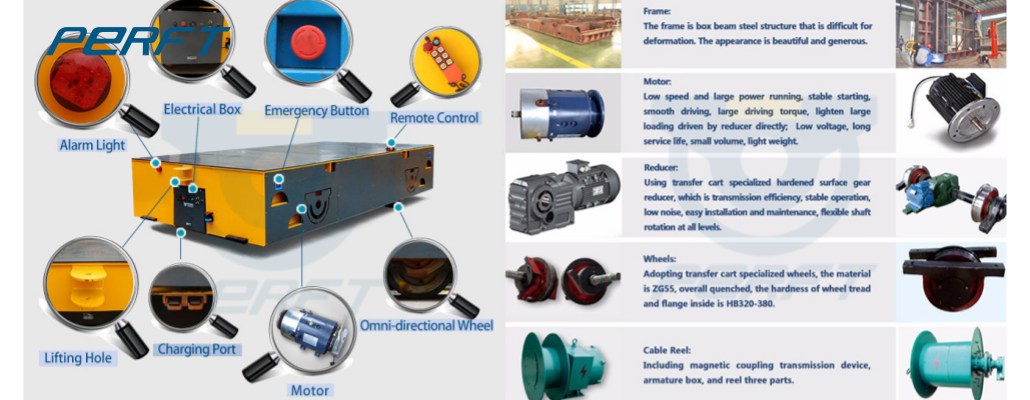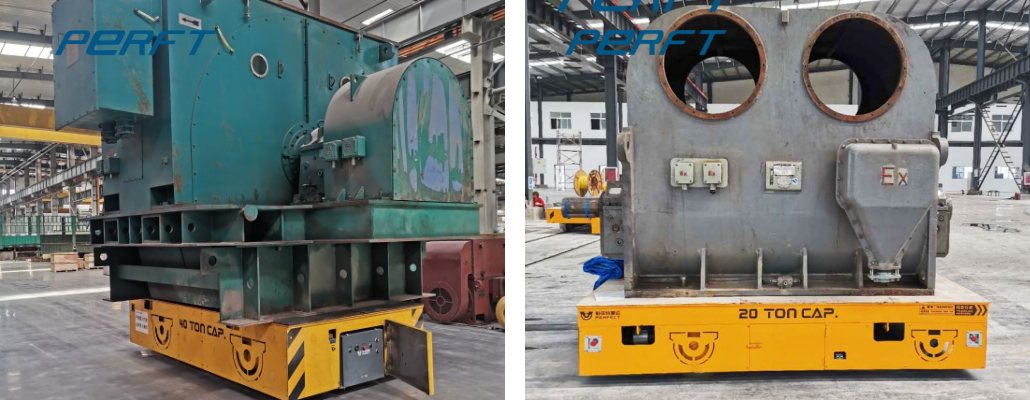Transfer trolley on wheels is mainly powered by batteries and controlled by control modules. It uses operating handles and control systems as inputs. It has a tabletop to load goods. The steering wheels guide the direction and carry the weight together with the fixed wheels. The motor provides the original power, and the reducer provides the power to the fixed wheels!
Electrical cart has a beautiful appearance and is easy to use. It can achieve 360-degree steering. The commonly used steering mechanism designs for transfer trolley on wheels include hydraulic steering and differential steering. The characteristics of the hydraulic steering method and its difference from conventional differential steering can be explained from the following aspects:
5 Ton Trackless Transfer Trolley Video
All electric transfer carts are equipped with warning alarm and security detection apparatus, and the alarm would ring and the car would stop immediately if there was any obstacle or pedestrian in the running path of the cart.
Characteristics of Hydraulic Steering Method
Structure and principle: The hydraulic steering system is usually composed of key components such as hydraulic pump, hydraulic cylinder, hydraulic valve, etc.
The working principle is to provide power through the hydraulic pump to drive the steering mechanism to achieve steering.
Control performance: The hydraulic steering system makes transfer trolley on wheels more flexible to control, and can easily cope with complex turns and narrow spaces, especially suitable for operations in small venues.
The hydraulic steering system can provide more precise steering control, especially transfer trolley on wheels on complex or uneven ground, its stability and safety are more prominent.
Load capacity: The hydraulic steering system is more suitable for large or super heavy trackless transfer trolleys, which can ensure the smooth steering of transfer trolley on wheels under heavy load, reduce tire wear, and extend service life.
Ease of operation: The hydraulic steering method is usually equipped with a remote control for operation, which is relatively simple to use and has no strict requirements on the road surface and tonnage.

Difference from Conventional Differential Steering
Construction differences: Differential steering relies on mechanical structures such as differentials and gear transmissions, while hydraulic steering relies on hydraulic components such as hydraulic pumps and hydraulic cylinders.
Different steering methods: Differential steering is a mechanical steering method that achieves steering by adjusting the speed difference between the drive wheels on both sides of trackless transfer cart. Hydraulic steering uses hydraulic pressure to transmit steering force to achieve steering effect.
Differential application scenarios: Differential steering systems are usually used on small to medium-sized transfer trolleys on wheels. Its main advantages are the flexibility and accuracy of control, and it can even achieve on-site steering, which is a huge advantage for industrial environments with limited space.
Hydraulic steering systems are more suitable for large or super-heavy steerable transfer carts, especially those that need to carry heavy goods.
Performance and cost: Differential steering systems have a relatively simple structure, low maintenance costs, and are easy to achieve automated control.
Although the hydraulic steering system has a relatively complex structure, its advantages in heavy-load stability and safety make it more competitive in certain application scenarios.

From many user cases, we can see that the hydraulic steering method of steerable transfer cart has significant characteristics in terms of control performance, load capacity, and ease of operation. It is significantly different from conventional differential steering in terms of structure, steering method, application scenario, performance, and cost. When choosing steerable transfer cart steering system, enterprises should decide based on their own transportation needs and working environment.
